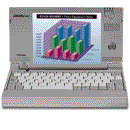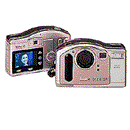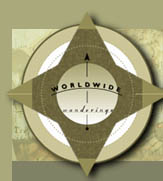|
Trip Preparation - Techie Stuff For those of you who are into this type of thing, the following is a list of the
equipment and software that we are using to publish this page. Now also seems a good
time to mention that, although I have been involved with technology for over 15 years
(mostly in sales), I don't consider myself incredibly technical. Bottom line, if I
can do this, almost anyone with a little determination can too. Anyway, this is the
"stuff" I've got in my bag-o-tricks.
 The computer - After some degree of research, I
chose the Toshiba Libretto 70CT. The biggest plus for the Libretto was the
size and weight of the machine. When traveling, at least in my opinion, weight is
paramount. At 1.8 lbs., the Libretto is one of the lightest Intel Pentium machines
that runs Windows '95. The icing on the cake was the size, or
"hide-ability" of the machine. At about the size of a video cassette, the
machine can easily be wrapped up in a T-shirt and stuffed into the bottom of our packs,
all to hopefully foil both crafty burglars as well as enterprising border guards.
Although not a powerhouse by today's standards, the Libretto 70CT uses a low voltage
Pentium 120Mhz processor with MMX technology, and 16MB of RAM (I expanded to 32MB) and a
1.5GB hard drive, into a remarkably small package. The Libretto 70CT also comes
standard with a 6.1'' active color VGA screen. I purcased the Libretto, the DC210,
the memory, the modem, and the photo card from NECX.com. I highly recommend them based on pricing,
availability, and on-line research info. The computer - After some degree of research, I
chose the Toshiba Libretto 70CT. The biggest plus for the Libretto was the
size and weight of the machine. When traveling, at least in my opinion, weight is
paramount. At 1.8 lbs., the Libretto is one of the lightest Intel Pentium machines
that runs Windows '95. The icing on the cake was the size, or
"hide-ability" of the machine. At about the size of a video cassette, the
machine can easily be wrapped up in a T-shirt and stuffed into the bottom of our packs,
all to hopefully foil both crafty burglars as well as enterprising border guards.
Although not a powerhouse by today's standards, the Libretto 70CT uses a low voltage
Pentium 120Mhz processor with MMX technology, and 16MB of RAM (I expanded to 32MB) and a
1.5GB hard drive, into a remarkably small package. The Libretto 70CT also comes
standard with a 6.1'' active color VGA screen. I purcased the Libretto, the DC210,
the memory, the modem, and the photo card from NECX.com. I highly recommend them based on pricing,
availability, and on-line research info.
The modem - I went for the best PCMCIA modem I could find. No
skimping with our "lifeline" to the outside world. We're using a Megahertz 56K
GLOBAL modem with V.90. The Global moniker means that the modem is easily (and
sometimes automatically) configured for the specifics of the country we're in, and the
connection we're making.
Makeing the physical comnnections to the phone lines -
Althougth the closest thing to a "standard" for telephone outlets is the RJ11
found in the U.S.A., Canada, and over 100 countries, there are 25+ other styles of plugs
required to connect with annalog phone lines throughout the world. I am carrying 11
of them - called Teleplug-Ins - from Austin
House.
Hosting and connecting to the 'net - With a little
advise from some of my friends "in the know" about such things, I hosted my page
on Mindspring. The biggest reason for this was that Mindspring offered FrontPage
extensions (a nesccessity for a non-techie like me). I've also selected IBM.net as my access provider. After
a little comparison, I found that IBM has the largest number of international POP's (or
Points of Presence, dail-in locations), and great support. As an added plus, because
IBM has been true to form in poorly promoting a great offering, I don't think I'll get
many busy signals when dailing in.
 The camera - After some comparison (I only looked at Kodak
models because I wanted world-wide, tech support and replacement/repair), I chose the DC210 Zoom camera.
I chose this camera based on a combination of functionality, size, and price. It
features a high resolution of 1152 x 864 pixels and 4MB of removable memory (I bought a
10MB photo card as well). Its picture quality and ultra-high resolutions with one
million pixels per image. Each picture is a detailed (up to) 3.5MB 24-bit color digital
image. The camera - After some comparison (I only looked at Kodak
models because I wanted world-wide, tech support and replacement/repair), I chose the DC210 Zoom camera.
I chose this camera based on a combination of functionality, size, and price. It
features a high resolution of 1152 x 864 pixels and 4MB of removable memory (I bought a
10MB photo card as well). Its picture quality and ultra-high resolutions with one
million pixels per image. Each picture is a detailed (up to) 3.5MB 24-bit color digital
image.
Publishing software - I'm using Microsoft
FrontPage for publishing. I decided on FrontPage, not so much based on features
and functionality, but because it is by far the most popular and widely used Internet
publishing package. In other words, there are more do-it-yourself books, more
discussion groups, and most importantly, more Internet professionals (such as the folks
who helped my design this site), that use and support FrontPage than any other package.
Photo manipulation software - Adobe PhotoDeluxe came
with the camera. I've played with it, but haven't had time to really put it through
the paces yet. More to follow when I do.
|



